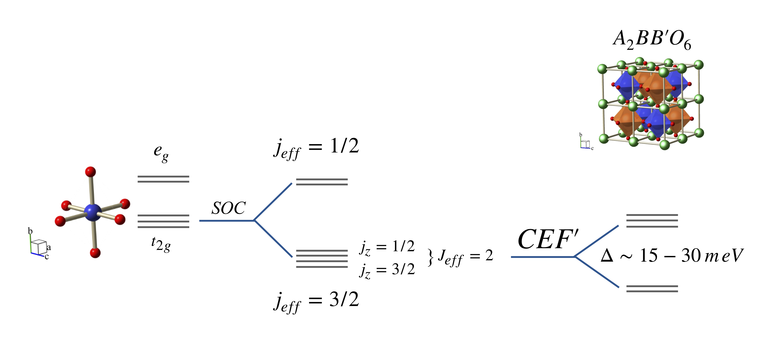
Figure: The materials studied are all cubic double perovskites with structure and chemical formula as shown at the top right of the figure. The local octahedral environment of the Os atom in these materials is shown on the left. The local environment of the Os atom and effect of spin-orbit coupling generates the hierarchy of electronic levels as demonstrated in the schematic.
Cerdanyola del Vallès, XX of April 2020. Ordered double perovskite magnets provide a fascinating avenue to study the interplay of geometric frustration with strong spin-orbit coupling. This interplay is predicted to yield exotic ground states.
A research team led by Prof. Bruce D. Gaulin and Dalini D. Maharaj from McMaster University; Dr. Clemens Ritter at the Institut Laue Langevin; Dr. Gabriele Sala and Dr. Matthew Stone at Oak Ridge National Laboratory; Dr. François Fauth at the ALBA Synchrotron and Prof. Arun Paramekanti at the University of Toronto, has provided the first evidence for a novel ordered ground state in a d-electron material. Their study has shown that double perovskite materials based on osmium (Os) (Ba2MOsO6, with M= Zn, Mg, Ca), display octupolar order at low temperatures.
These results add to the fundamental understanding of the complex electronic and magnetic behaviour of highly topical double perovskite magnets based on d-electron ions. These materials have been recently studied due to their relevance in the broader study of frustrated magnetic interactions.
From the point-of-view of the methodology employed in the study of these systems, this study highlights the importance of corroborating experimental findings and conclusions among a variety of experimental techniques. This is clear from the fact that Ba2CaOsO6 and Ba2MgOsO6 were previously thought to host long-range ordered magnetic ground states based on heat capacity, magnetization and muon spin relaxation measurements. However, utilizing the strengths of inelastic neutron scattering and x-ray diffraction provide further insight into the fact that these systems host highly non-trivial magnetic behaviour.
This study employed a series of neutron and x-ray techniques that provided the necessary clues to pinpoint the unique properties of these double perovskite magnets. Inelastic neutron scattering measurements were performed to probe the existence of low lying excitations of the magnetic systems below their transition temperatures. High-intensity neutron powder diffraction experiments were performed to determine whether these systems, which possess weak magnetic moments, develop magnetic long-range order. The x-ray synchrotron measurements were performed to determine whether Ba2CaOsO6 (the system which was most likely to host a magnetic long-range ordered state) undergoes a structural transition. The high angular resolution measurements performed at the MPSD beamline were central to the finding that Ba2CaOsO6 remains in its high symmetry cubic structure below this transition temperature.
The fact that Ba2CaOsO6 maintains cubic symmetry implies that the magnetic features which were measured below the transition temperatures are not associated with a structural distortion. Based on this new framework for understanding these systems the high cubic symmetry forbids the magnetic behaviour from arising from a quadrupolar ordered ground state. This point is of significance as cubic double perovskite magnets were previously predicted to potentially host a quadrupolar ground state.
Such a novel octupolar-ordered phase had only been previously observed in f-electron materials. As d-electron systems and f-electron systems display different hierarchies of electron energy scales. This research provides the first comprehensive framework for understanding how such an octupolar phase might be stabilized and identified in d-electron double perovskite materials.
Reference: D. D. Maharaj, G. Sala, M. B. Stone, E. Kermarrec, C. Ritter, F. Fauth, C. A. Marjerrison, J. E. Greedan, A. Paramekanti, and B. D. Gaulin. Octupolar versus Néel Order in Cubic 5d2 Double Perovskites. Phys. Rev. Lett. 124, 087206. DOI: 10.1103/PhysRevLett.124.087206




